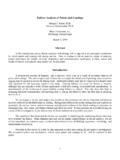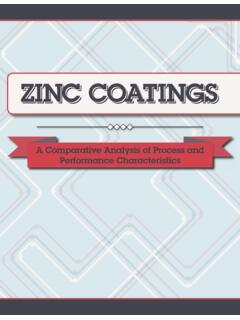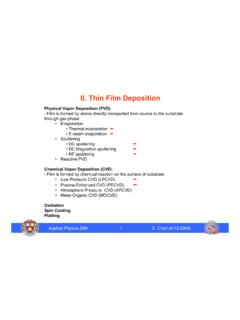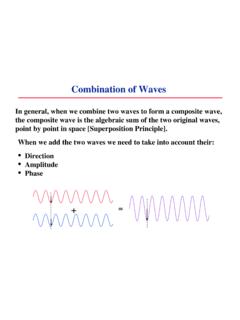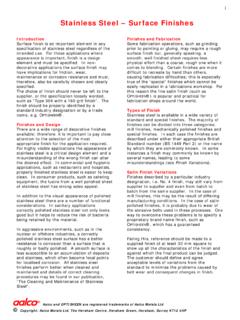Transcription of GalvInfoNote Understanding Coating Weight …
1 GalvInfo Center email: Toll-free phone: 1-888-880-8802 1 GalvInfoNote 1 Understanding Coating Weight Designations for Zinc-Based Coatings on Steel Sheet Rev Jan-04 Introduction One of the most confusing topics related to coated-steel sheet products is the issue of Coating Weight designations and what they mean with respect to product performance. This discussion is intended to help clarify this issue. Coating Weight Measurement Systems Each coated-steel sheet product has a Coating Weight designation system that is in common use today. The system for each type of Coating is defined in the appropriate ASTM standard. For example, the most commonly used ASTM standard is A 653/A 653M which covers hot-dip galvanized products. The Coating Weight designation system is given in terms such as G60, G90, etc.
2 These numbers refer to the Weight (mass in SI units) of zinc on the surface of the steel sheet in Inch-Pound (English or Imperial) units of measurement. That is, for G90, the Coating on one square foot of sheet (total Coating , both sides of the sheet) weighs a minimum of ounces. If equally applied to both sides of the sheet, there would be a minimum of ounces on each surface. The other measurement system in widespread use today is the SI (Metric) system. The conversion from the Inch-Pound Weight in ounces per square foot (oz/ft2) to the SI mass in grams per square metre (g/m2) is: 1 oz/ft2 = g/m2 To convert from oz/ft2 to g/m2, multiply by Example: G90 ( oz/ft2) = Z275 (275 g/m2) Since what we are most interested in is the Coating thickness, why don t the ASTM standards use thickness measurements? The answer is simply that it is difficult to directly measure the thickness accurately.
3 For example, a G90 Coating contributes about mils ( inches) of thickness to the final coated sheet. For a Coating equally applied to both sides of the sheet, this means there is about inches of zinc on each surface. Thus, to accurately determine the thickness of the Coating , one needs to know the precise thickness of the steel and then use a thickness gauge capable of accurately reading to the nearest ten thousandth of an inch1. It is much easier, and more accurate, to use a weigh-strip-weigh procedure to determine the Weight of Coating . Weigh-strip-weigh refers to the technique of weighing a standard-sized sample of the product using a very accurate scale, then stripping the Coating in a mild acid to remove only the Coating , then reweighing the coupon to determine the Weight loss. Hence, the origin of the term weigh-strip-weigh . There are weigh-strip-weigh procedures that can be used for all zinc-based coatings in commercial production today.
4 For the most common products, these procedures are defined in ASTM Standard A 90/A 90M, and cover galvanized and galvannealed coated sheet, Galvalume coated sheet, and Galfan coated sheet. There are special procedures required for other types of alloy coatings such as zinc-nickel alloy electroplated sheet. These are covered by other ASTM standards. Galvalume is a registered trademark of BIEC International, Inc. Galfan is a registered trademark of the Galfan Technology Centre, Inc 1 Today, there is a very precise on-line (on the Coating line) technique being used by most producers to determine Coating Weight . This method could be used by the customer to determine Coating thickness, but the equipment required is very expensive and it encompasses the use of sophisticated x-ray or radio-isotope fluorescence devices to measure the Coating Weight ; equipment that is not easy for a user of the product to acquire or use.
5 The devices, in fact, directly measure the actual Coating thickness repeatedly, and then average and convert the readings to the more familiar Coating Weight units. Refer to ASTM Test Method A 754 for more information. GalvInfoNote #1 Rev Jan-04 GalvInfo Center email: Toll-free phone: 1-888-880-8802 2 Designation System for Galvanized and Galvannealed Coated Sheet Products For galvanized sheet, the common Inch-Pound Coating Weight designations (ordered as A 653) are, in oz/ft2: G30 G40 G60 G90 G115 There are other designations such as G165 and G210, but these products are used for very specialized applications. In SI units (ordered as A 653M), the comparable Coating mass designations for galvanized sheet are, in g/m2: Z90 Z120 Z180 Z275 Z350 For galvanized coatings in most applications and environments, the corrosion performance is approximately linear as a function of Coating Weight (thickness).
6 That is, a G60 Coating has twice the thickness of a G30 Coating , and the life of the product (defined, perhaps, as the time to 10% rust) in a given environment is approximately twice as long. Similarly, a G90 Coating is approximately 50% thicker than a G60 Coating , and thus would be expected to perform 50% better (in terms of time to 10% rust). Limits on maximum acceptable Coating weights for an application are usually given by other factors such as cost or formability. For a more thorough discussion of this topic see GalvInfoNote #s 11 and 19. For other metallic-coated sheet products, the life versus Coating thickness is not typically linear; thus, determining the Coating Weight (mass) to use is not as simple as it is for galvanized coatings. Also, when these products are painted, the behaviour is even more complex. The subject of painted hot-dip products is addressed in GalvInfoNote #s 8 and 20.
7 The common Inch-Pound Coating Weight designations (ordered as A 653) for galvannealed product are, in oz/ft2: A25 A40 A60 As with the galvanized product designators, A40 for example requires a minimum Coating Weight of oz/ft2. Because the Coating contains approximately 8 to 10% iron, the density is slightly different than the density of zinc and the Coating thickness is not quite the same as for a G40 galvanized Coating , although the difference is too small to be of concern. The effect of density will be discussed later in this GalvInfoNote . Also, see GalvInfoNote #5 for a full explanation of hot-dip galvannealed coatings. The SI equivalent Coating mass designations (ordered as A 653M) for galvannealed sheet are, in g/m2: ZF75 ZF120 ZF180 For galvanized and galvannealed coated sheet, the relationship between Coating Weight (mass) and thickness is as follows: 1 oz/ft2 = in = g/m2 = mm (1) GalvInfoNote #1 Rev Jan-04 GalvInfo Center email: Toll-free phone: 1-888-880-8802 3 Designation System for Electrogalvanized Coated Sheet Products For electroplated coatings (pure zinc and all the alloy coatings), the most common designator unit in use today is the SI system (g/m2).
8 Refer to ASTM Standard A 879/A 879M, which until 2004 did not even include the Inch-Pound (oz/ft2) designator system. The stimulus for this common use of the SI designators is that most electroplated products2 are used for automotive applications and the automotive companies, who implemented worldwide specifications some time ago, adopted the use of SI units. More recently, as hot-dip galvanized and galvannealed coatings have seen increasing use by the automotive industry, it became the practice to manufacture these products to conform to g/m2 requirements instead of oz/ft2; hence automotive specifications for hot dip coated sheet contain only SI designators. This use of both dimensional units has led to considerable confusion in the marketplace. What adds to this confusion is that for ASTM electrogalvanize products, and for all automotive specifications covering EG and hot-dip, the use of the letter G means it is a SI Coating .
9 Conversely, use of the letter G in the Coating designator of ASTM hot-dip products means it is an Inch-Pound Coating . For example, the designator 40G40G (sometimes referred to loosely as G40/40) in A 879/A 879M (g/m2), is easy to confuse with A 653/A 653M G40 (oz /ft2), especially since both hot-dip galvanize and electrogalvanize can be referred to (incorrectly) by the G40/40 term. Also, almost all automotive specifications require designation of the Coating mass on each side of the sheet, , 40G40G, requires 40 g/m2 on each side. The Inch-Pound term G40, a designator used only for hot-dip galvanized sheet, is defined by A 653/A 653M as total Coating Weight , both sides. It has approximately oz /ft2 (70 g/m2) of Coating on each side of the strip, if the Coating is equally divided. This issue is further confused by the adoption of unclear language in the trade.
10 As mentioned, some people might refer loosely to 40G40G as G40/40 or even G40. If the steel producer made the product to meet automotive 40G40G (40 g/m2 minimum on each side), the Coating is not as thick as if the producer had made the product to meet a G40 Coating Weight (oz /ft2). Similar confusion is introduced by intermixing use of G60 per ASTM A 653/A 653M and G60/60 (correctly 60G60G) per A 879/A 879M (or per an automotive company s 60G60G, SI designation). It is not easy to keep the terminology straight, but users should be aware that both units are in common use today, and are advised to pay close attention when ordering and know precisely what is meant by the terminology being used. See the Table 3 at the end of this article, which summarizes all of the designations and may be useful in keeping confusion to a minimum. GalvInfoNote #3 explains the electrogalvanizing process.
